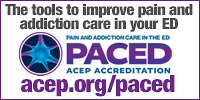- May 1,2025 | ISSN 1940-6967
- The National Association Of Medical Doctors
Featured Sponsors
Here's A Replacement For Prior Authorization
By Michele Kowalski-McGraw, MD, MPH, Larry Ozeran, MD, Manijeh Berenji, MD, MPH, & Richard Schreiber, MD
For many clinicians, it's the small victories -- saving a patient from a life-threatening injury, helping a patient obtain much-needed medical treatment for cancer -- that bring immense satisfaction and joy in medicine.
But what happens when prescribed care is denied?
The stated objectives of prior authorization (PA) are to reduce unnecessary care and costs. However, as a 2022 Department of Health and Human Services Office of the Inspector General report highlighted, prior authorization can reduce access to care through the delay or denial of medically necessary medications and services. Several studies suggest prior authorization costs billions of dollars annually. According to a recent survey, prior authorization creates administrative roadblocks that frequently result in delayed care; increases costs for patients, caregivers, clinicians, and employers; and contributes to moral injury. Nearly 25% of physicians report that prior authorization has led to a serious adverse event for a patient in their care.
An Alternative to Prior Authorization
Given these alarming statistics, the End Burnout Group (EBG), a multi-disciplinary group of clinicians and informaticists which we lead, identified prior authorization as a leading root cause of burnout. We propose evidence-based care optimization (ECO) to minimize unnecessary care while better serving patients, clinicians, and the economy. ECO leverages existing digital tools to automate the certification of clinical appropriateness using national clinical guidelines, and integrates a separate digital insurance query to determine coverage terms. The goal is to separate certifying clinical appropriateness from determining insurance coverage.
Health insurers use prior authorization to make clinical decisions despite the inherent conflict of interest: the lowest cost care is no care. ECO shifts the current paradigm by trusting clinical judgment in care decisions while verifying it meets clinical guidelines. This approach can end inappropriate denials and unnecessary delays that harm patients.
ECO in Practice
So, how exactly does it work? ECO seeks national guidelines when clinicians place an order in the Electronic Health Record (EHR). It is important to emphasize that ECO is not prior authorization. The goal is to defer to clinical judgment unless there is evidence that the care being proposed conflicts with available guidelines. When no guidelines exist, ECO certifies the order as clinically appropriate. When evidence-based guidelines exist, ECO extracts relevant EHR data and compares them to the guidelines to assess clinical appropriateness. When orders meet the guidelines, ECO certifies the orders as clinically appropriate. If a guideline requires data not in the record, ECO informs the clinician of missing elements needed to meet the guidelines or alternate options where the existing data meet guidelines. A clinician could immediately place a revised order.
In the ECO paradigm, insurers do not determine clinical appropriateness. They only determine how much they pay for a service based on the specific insurance agreement with the individual or employer. Once care has been certified as appropriate via ECO, insurers receive a digital message and must respond (digitally) to the authenticated sender in minutes, directly or via a clearinghouse, with a coverage determination. Patients and clinicians know immediately whether a service is covered and its cost, making shared decision-making easier and avoiding prior authorization-caused delays in needed care.
EBG envisions ECO as an open-source project that uses existing tools to determine if documentation within the EHR comports with national guidelines. This eliminates the need to build different apps in each EHR, speeds implementation and updates, and streamlines national analysis and reporting of effectiveness and outcomes. The features needed to enable ECO are similar to the CDC's Electronic Case Reporting. The Agency for Healthcare Research and Quality-funded Clinical Decision Support Consortium established the feasibility of real-time decision support from a centralized guideline repository, showing that this is not a technical barrier.
ECO requires a governance process and organization to manage ECO development and incorporate updated guidelines as data change. EBG recommends this process be independent of current medical and informatics societies. The open-source model is likely to support this need; all societies would be able to send representatives to participate in the development and update processes.
To date, only a few medical societies have developed computer algorithms to support their clinical guidelines. The advent of large language models that can write software may make converting to computer-ready guidelines easier. The American Academy of Pediatrics' Partnership for Policy Implementation processes run guidelines through an informatics process to assure computability and eliminate ambiguity. Some of these have been converted into apps.
EBG envisions a transition and building period where prior authorization is gone and guidelines for ECO are added methodically. Some would come from converting existing guidelines into the ECO format and some could be driven by health plan requests. The harm from prior authorization is so great that its elimination should not wait until ECO is fully functional. First, do no harm.
Legislating Change
It will take a national commitment to achieve this vision. Universal deployment of ECO will require legislation to prohibit health insurance plans from using prior authorization or any other process to determine clinical appropriateness and require them to digitally respond to certified orders immediately upon receipt. Legislation or new regulations from the Assistant Secretary for Technology Policy could require EHR vendors to use ECO. This will likely face significant push-back from insurers.
However, in the interest of better health and reduced costs, it's high time for change. The transition costs can be recouped many times over from time and cost savings, reduction in patient harm, and the reduction in burnout that comes from clinicians seeing that they, not insurers, are the ones managing patient care.
Prior authorization is dangerous and actively causes harm. It needs revolutionary change, not just faster processing features or minor adjustments. There is an inherent conflict of interest in having insurers make decisions about the clinical appropriateness of services for which they must pay. To end the harm, clinical appropriateness must be separate from contractual coverage and actuarial assessments. It's time to replace prior authorization with certification using evidence-based care optimization and digital coverage notification.
Articles in this issue:
- Would You Rather Get Care In The US Or Abroad?
- Malnutrition-Related Diabetes Officially Named ‘Type 5’
- Suicide Reverberates Among Young Doctors
- Here's A Replacement For Prior Authorization
- Residency As Rehearsal: The New Pediatric Hospitalist Fellowship Requirement Scam
- Treat AFib ‘Diagnosed’ By Smartwatch?
- 3 Factors Driving Up The Cost Of Care For Physicians
Top Physician Opportunities
Journal of Medicine Sign Up
Get the Journal of Medicine delivered to your inbox.
In This Issue
- Would You Rather Get Care In The US Or Abroad?
- Malnutrition-Related Diabetes Officially Named ‘Type 5’
- Suicide Reverberates Among Young Doctors
- Here's A Replacement For Prior Authorization
- Residency As Rehearsal: The New Pediatric Hospitalist Fellowship Requirement Scam
- Treat AFib ‘Diagnosed’ By Smartwatch?
- 3 Factors Driving Up The Cost Of Care For Physicians
Archives
Masthead
-
- Editor-in Chief:
- Theodore Massey
- Editor:
- Robert Sokonow
- Editorial Staff:
- Musaba Dekau
Lin Takahashi
Thomas Levine
Cynthia Casteneda Avina
Ronald Harvinger
Lisa Andonis
Leave a Comment
Please keep in mind that all comments are moderated. Please do not use a spam keyword or a domain as your name, or else it will be deleted. Let's have a personal and meaningful conversation instead. Thanks for your comments!















*This site is protected by reCAPTCHA and the Google Privacy Policy and Terms of Service apply.